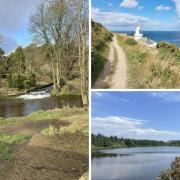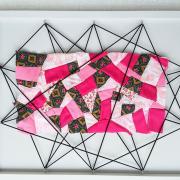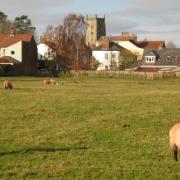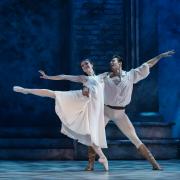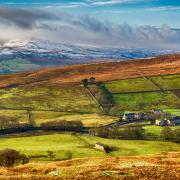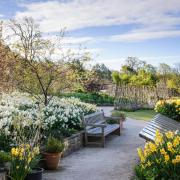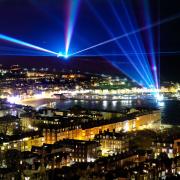Esther Leach takes a look at the Mr Turner and Mr Girtin: The Early Years exhibition

A new exhibition opens in Yorkshire bringing together for the first time in 100 years all six watercolours of Harewood painted by JMW Turner. Mr Turner and Mr Girtin: The Early Years is also a unique opportunity to directly compare Turner and Thomas Girtin. Both were commissioned early in their careers to paint the same views of Harewood and it is at the stately home near Leeds, that their work is exhibited this month.
‘Turner has certainly had a lot of exposure recently,’ says David Lascelles, Earl of Harewood. ‘There was the blockbuster Late Turner show at Tate Britain last year and Mike Leigh’s movie Mr Turner, with Timothy Spall portraying the artist in his last years. So we thought this was a good opportunity to shine a different light on him at the very beginning of his career, when he was invited to paint watercolours at Harewood by the man who was his first major patron, Edward “Beau” Lascelles.
‘Turner visited Harewood with his great friend and colleague Thomas Girtin and it is intriguing to compare their very different approach to painting very similar views. Girtin died a few years later, aged just 27. Turner paid for his funeral and later remarked “If Tom Girtin had lived, I would have starved”. It is intriguing to speculate how their careers might have developed if Girtin had lived longer.
‘Turner and Girtin’s visit and Beau Lascelles patronage of other watercolourists was the start of the Harewood tradition of supporting young and innovative artists, a tradition that continues to this day. You could say that Harewood House is the oldest contemporary art gallery in Yorkshire!

‘This is also the first time for over 100 years that all the watercolours Beau commissioned Turner to paint have been shown together, with the return of his painting of Harewood Castle from the South.’ The Harewood watercolours became separated in 1858 and for the last 100 years the family has worked to reunite the collection. This spring sees the final completion of the six major Harewood watercolours painted by Turner in 1797-98 with the acquisition of Harewood Castle from the South. The watercolour includes detail of two young men side by side in the foreground. It is believed one is a self-portrait of Turner, working in a large sketchbook, and the other his friend Girtin.
The two men share similar backgrounds and their careers followed very similar paths until Girtin’s early death in the 1802. They were both born within weeks of each other in 1775 and within a stone’s throw of one another in London. They both apprenticed to artists of similar standing, Girtin to Edward Dayes and Turner to Thomas Malton. The both undertook similar work as young men colouring prints and producing work for publication.
‘They both enjoyed patronage from Edward Lascelles, the second Earl of Harewood in the 1790s.
‘Mr Turner was not always eccentric or famous,’ says Prof David Hill, Harewood Fellow at the University of Leeds. ‘In his early years he was shy and success was by no means assured. He had rivals and chief among these was his friend Thomas Girtin. They were born in 1775 and aged 21 both came to the attention of Edward “Beau” Lascelles of Harewood.

‘They were at the beginning of their professional careers. Girtin came to Yorkshire in 1796 and Turner followed in 1797. By all accounts Girtin dazzled and Turner was uncomfortable in company. Lascelles thought them the best young artists in Britain and commissioned numerous early masterworks. All of their important Harewood subjects remain in the collection, and this exhibition allows us to compare their work directly in the setting that inspired their success.
‘Mr Turner and Mr Girtin were born little more than two months apart, and little more than a mile; Girtin on 18 February in Southwark and Turner on 23 April on the north side of the Thames in Covent Garden. Both came from working families, Girtin’s father was a brushmaker, Turner’s a hairdresser.
‘They learned their trade with London artists and in the evenings attended an informal academy at the home of Dr Thomas Monro, physician to George III. For pocket money and a supper of oysters they copied works from Monro’s collection.
‘They were very different characters. Turner was shy and hardworking; Girtin precocious and quick. While Turner immersed himself in his work, Girtin dazzled with the swordplay of his brush. Beau Lascelles preferred Girtin: Turner, he said, effected his purposes by industry; Girtin had the greater genius.
‘Girtin died suddenly in 1802, aged only 27. Turner lived another 50 years. What Girtin might have done is one of the great ‘What ifs’ of art history. Turner paid for him to be buried in St Pauls, Covent Garden, his own baptismal church. He paid final tribute to his friend’s great talent with the words: ‘If Tom Girtin had lived, I would have starved’.
Harewood tradition
Beau Lascelles was primarily a collector of contemporary art,’ says Prof Hill. ‘His taste was for the innovative, not quite proper, art of younger artists. Those he favoured came from working backgrounds and were radical in style and sometimes manner. Establishment opinion found them ‘uncouth’ and even subversive. The criticism sounds very like that of the Young British Artists of recent years.
‘Lascelles indulged in every fashion and was often compared to the Prince of Wales. His Royal Highness did not approve. He started buying regularly from Turner and Girtin in 1797-8 paying 10 guineas for each of Turner’s Harewood subjects and 20 guineas for each of Girtin’s larger Harewood watercolours. He collected works intensively for 10 years and encouraged other emerging artists such as John Varley, John Sell Cotman, Augustus Wall Callcott, Peter de Wint and William Havell. At his death in 1814 his collection of modern art must have been one of the best in Britain.
Beau Lascelles stands at the beginning of a tradition of collecting contemporary art at Harewood. The house contains examples from every generation since the first Earl, and emerging artists remains a vital interest. The Terrace Gallery is normally dedicated to the new but this exhibition reminds us that at Harewood the contemporary has a history of 200 years.’
April 3rd – July 5th
Mr Turner and Mr Girtin: The Early Years
Terrace Gallery, Harewood House






